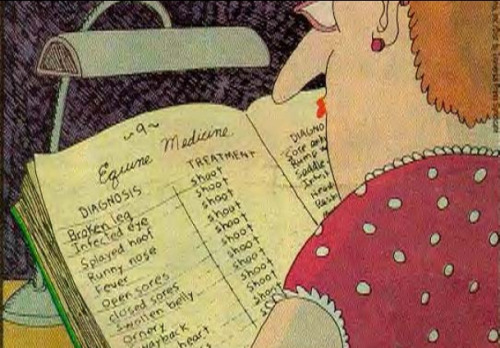Barks Blog
The Far Side Of Behavior Solutions
One of my favorite Gary Larson, Far Side cartoons, is a drawing of a girl reading a book about equine medicine with the caption, “Doreen breezes through her first semester of veterinary school.” The page shows a long list of possible horse ailments and only one antidote…shoot him!
Unfortunately this is how a lot of people deal with their dog’s behavioral issues. And while symbolically shooting the dog may seem like the right thing to do, after all the dog is “behaving badly” and therefore needs to be taught a lesson; however using violence as a way to correct the behavior will not get the results you are after. Sure you may stop the behavior dead in it’s tracks because you have stunned the dog, but that behavior is only being suppressed and may resurface as a totally different and seeming unrelated problem! In some instances, you may have unwittingly created a ticking time-bomb!
Dogs will do a lot of behaviors that have similar mechanics, so taking the behaviors barking and lunging for example, a dog may bark and lunge if he’s frightened or if he’s very excited, and while the physical behaviors are identical, the emotions “driving” the behavior are different, and causing pain to the dog is NOT the antidote for an excited and or fearful dog. In fact if you hurt a friendly dog he may become fearful; likewise, hurting the dog for being fearful is not going to make him courageous!
Looking at some of possible reasons why a dog barks and lunges, (fear, agitation, excitement etc.) try to imagine jerking, hitting, shocking and or yelling at the dog and expecting that the outcome will be a happy or friendly dog toward other adults, dogs, children or whatever “thing” it is they are “concerned” about.
A fearful dog may bark and lunge in order to get the “thing” to go away.
A frustrated/agitated dog may bark and lunge to get within striking range of the “thing”
A friendly/excited dog may bark and lunge to play with the “thing”.
In all the above behaviors we should consider what is motivating the dog and then apply the appropriate technique to help the dog, not hurt him!
If a dog is showing “concern” then it makes sense to condition the dog such that when one of his “triggers” shows up so does his favorite thing (food, toy or an activity). Over time, the dog begins to anticipate that the trigger is a predictor of the “good stuff” which changes the dog’s emotions. When his emotions have changed, the physical behavior will follow. And for the friendly/excited dog who is barking and lunging, while he may only want to play, if we do not set boundaries, we could end up with a frustrated, over the top excited, dog who just doesn’t know an appropriate response.
By teaching him a new behavior, and rewarding it frequently, we now have a dog that knows what to do instead of barking and lunging. And by the way, “friendly” should be the goal of all the above behavioral issues, so it makes sense that once the dog’s emotional state has been successfully changed from “concern” to “feeling good”, that we also teach a new behavior response, for example, when he sees a former trigger, he looks at his person and is reinforced.
This non-confrontational method not only gives the dog a different behavior to do, but also, it keeps his emotions stable because we have not hurt the dog in the process.
The next time you’re inclined to “shoot the dog” because of some perceived behavior infraction, remember using pain as the antidote for dog behavioral issues is like taking advice from a cartoon!
For more dog training advice, don’t forget to check out the PPG’s event page for information on the 3 day workshop in Florida.

